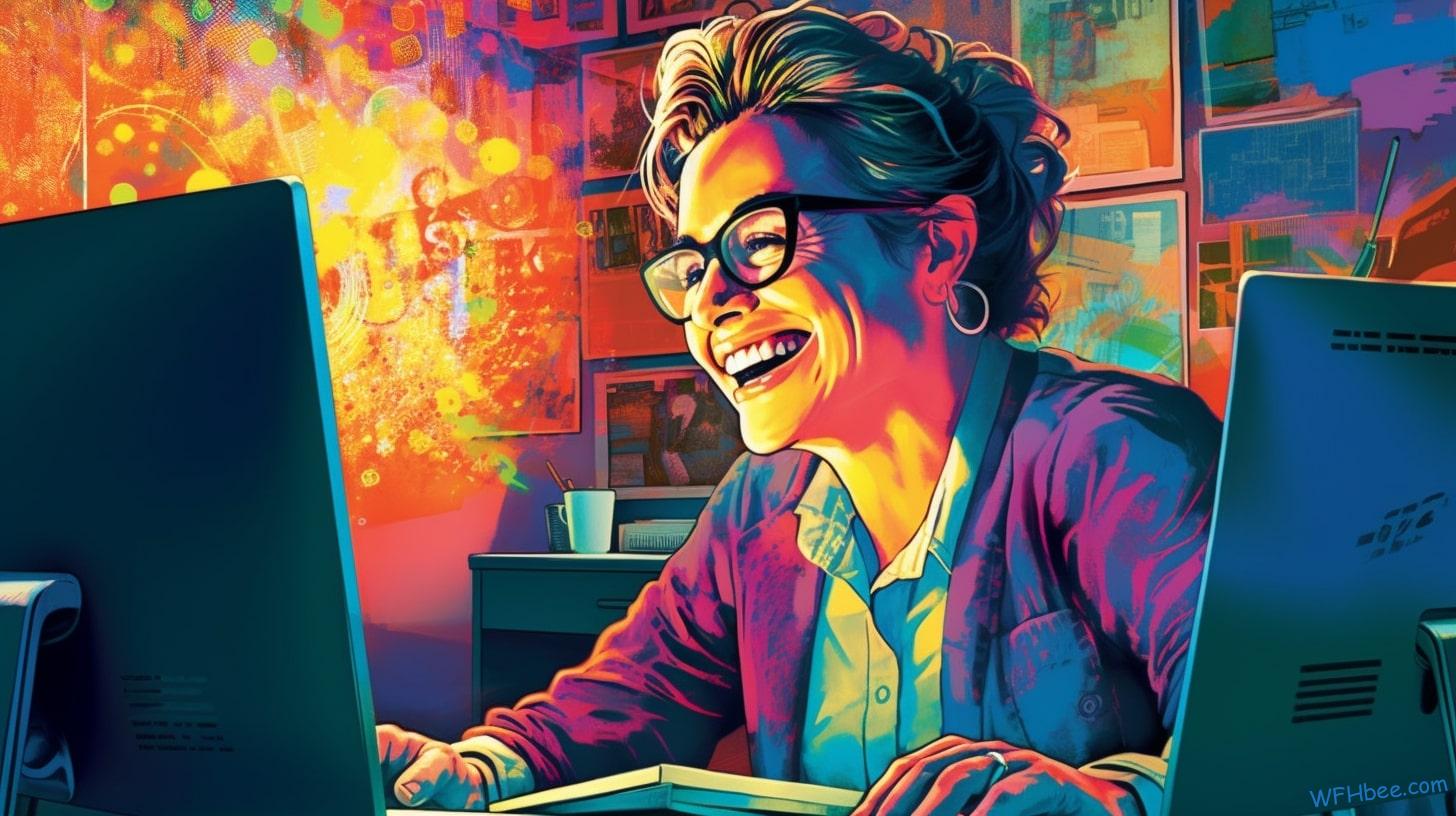Imagine being able to work as a video editor from the comfort of your own home. No more long commutes or rigid office hours. With remote work for video editors, you have the freedom to edit videos on your own terms.
This article will explore the benefits of remote work, guide you in setting up your home editing studio, and provide tips on managing projects and finding opportunities.
Embrace the future of video editing and unlock your creative potential from anywhere in the world.

Table of Contents

Benefits of Remote Work for Video Editors
You’ll enjoy the flexibility and increased productivity that comes with remote work as a video editor. As a video editor, one of the greatest benefits of remote work is the freedom it gives you to choose your own schedule. No longer bound by traditional office hours, you have the flexibility to decide when and where you want to work. Whether you’re an early bird or a night owl, remote work allows you to tailor your editing schedule to your own productive hours.
Another advantage of working remotely as a video editor is the ability to eliminate time wasted on commuting. Instead of spending hours stuck in traffic or rushing through crowded public transportation, you can simply walk over to your home office and start editing right away. This not only saves valuable time but also reduces stress levels, allowing you to focus more on creating high-quality videos.
In addition, remote work enables you to create an ideal working environment tailored specifically for your needs. You have complete control over your workspace – from choosing the perfect desk setup and ergonomic chair to setting up optimal lighting conditions for color grading. With fewer distractions and interruptions commonly found in traditional office settings, you can concentrate better on your edits and achieve higher levels of productivity.
To further enhance your efficiency as a remote video editor, here are some tips for an effective workflow:
1) Set clear goals and deadlines for each project.
2) Organize your files logically using folders and naming conventions.
3) Utilize cloud storage solutions for easy access to files from anywhere.
4) Communicate effectively with clients or team members through online collaboration tools.
5) Take regular breaks and maintain a healthy work-life balance.

Setting Up Your Home Editing Studio
To create a professional editing environment, make sure your home studio is properly equipped and optimized for efficient workflow. When setting up a comfortable workspace for remote video editing, it’s important to consider both the physical and digital aspects of your setup.
First, let’s talk about the physical space. Choose a quiet area in your home where you can focus without distractions. Set up a desk or workstation that allows you to comfortably sit for long periods of time. Invest in an ergonomic chair to support your posture and prevent back pain. Arrange your equipment, such as monitors and speakers, in a way that maximizes efficiency and minimizes clutter.
Next, optimize the digital aspect of your workspace. Make sure you have a reliable internet connection with sufficient bandwidth for uploading and downloading large files. Consider investing in external hard drives or cloud storage solutions to keep your projects organized and easily accessible.
Creating a productive routine for remote editing sessions is also crucial. Establish a schedule that works best for you, whether it’s early mornings or late nights. Break down your tasks into manageable chunks and set specific goals for each session. Take regular breaks to combat eye strain and maintain focus.
Incorporate healthy habits into your routine as well. Stay hydrated by keeping a water bottle nearby, stretch regularly to avoid stiffness, and take time away from screens to rest your eyes.

Essential Equipment for Remote Video Editing
Make sure you have the essential equipment for efficient editing, such as a powerful computer, high-quality headphones, and a reliable microphone.
As a video editor who desires freedom, working remotely offers numerous advantages. Firstly, you have the flexibility to work from anywhere in the world. Whether it’s the comfort of your own home or a cozy café overlooking a scenic view, remote work allows you to choose your ideal workspace.
This freedom also extends to your schedule. You no longer have to adhere to strict office hours but can instead organize your day in a way that suits you best.
However, with these advantages come some challenges that you need to be prepared for. One of the main challenges of remote work is creating a dedicated and distraction-free environment. Since you won’t have colleagues or supervisors physically present around you, it’s important to establish boundaries and set clear expectations with those sharing your space.
Additionally, communication can sometimes be tricky when working remotely. It’s crucial to have reliable internet connectivity and utilize tools like video conferencing software for seamless collaboration with clients or team members.
To overcome these challenges and fully enjoy the benefits of remote work as a video editor, investing in quality equipment is essential. A powerful computer will ensure smooth editing processes while high-quality headphones allow for accurate audio monitoring. A reliable microphone enables clear communication during virtual meetings or voiceovers.

Choosing the Right Video Editing Software for Remote Work
If you’re looking for efficient editing software, it’s important to choose the right one for your needs. As a video editor working remotely, finding the perfect video editing software can greatly enhance your productivity and freedom.
Here are three key factors to consider when comparing different options:
- User-Friendly Interface: When working remotely, time is of the essence. You want a video editing software that has an intuitive interface and easy-to-use features. Look for tools that allow you to navigate seamlessly through your projects and make edits effortlessly.
- Compatibility and Flexibility: As a remote video editor, you may need to collaborate with others or work on different devices. Ensure that the software you choose is compatible with various operating systems and supports popular file formats. This will enable you to easily share your work with clients or colleagues without any compatibility issues.
- Advanced Editing Tools: To create high-quality videos, it’s important to have access to advanced editing tools such as color grading, motion tracking, and audio enhancement capabilities. These features not only save time but also allow you to add professional touches to your videos.
By carefully considering these factors in your video editing software comparison, you can find the best option that meets your specific needs as a remote worker.

Managing Remote Projects and Collaborating With Clients
Collaborating with clients on remote projects can be made easier by utilizing project management tools and effective communication strategies.
As a video editor working remotely, managing remote teams and effectively communicating with your clients is crucial for the success of your projects. Fortunately, there are several tools and strategies available that can help you streamline your workflow and ensure smooth collaboration.
Firstly, when it comes to managing remote teams, project management tools such as Trello or Asana can be incredibly helpful. These platforms allow you to create tasks, assign them to team members, set deadlines, and track progress in real-time. By utilizing these tools, you can keep everyone on the same page and ensure that all aspects of the project are moving forward smoothly.
In addition to project management tools, effective communication with remote clients is essential. Video conferencing platforms like Zoom or Google Meet provide an excellent way to connect with your clients face-to-face even though you may be miles apart. Schedule regular check-ins or status meetings to discuss the progress of the project, address any concerns or questions they may have, and gather feedback.
Furthermore, using cloud storage solutions like Google Drive or Dropbox enables seamless file sharing between you and your clients. You can easily upload edited videos for review or receive raw footage from them without any hassle.
Ultimately, successfully managing remote projects boils down to clear communication and efficient collaboration. Embrace these project management tools and effective communication strategies to foster strong relationships with your clients while enjoying the freedom of working remotely.

Tips for Efficient Remote Video Editing Workflow
Now that you’ve mastered the art of managing remote projects and collaborating with clients, let’s dive into some tips for an efficient remote video editing workflow.
With the right tools and effective communication, you can create high-quality edits from the comfort of your own home.
To start off, consider exploring different remote video editing software options. There are several platforms available that allow you to edit videos seamlessly in real-time with your team. Look for software that offers features like collaborative editing, file sharing capabilities, and easy access to project files. These tools will help streamline your workflow and ensure smooth communication with your clients.
Once you have the right software in place, it’s important to establish effective remote client communication. Here are three key tips to keep in mind:
- Set clear expectations: Clearly communicate deadlines, deliverables, and any specific requirements or preferences your client may have. This will help avoid misunderstandings and ensure everyone is on the same page.
- Regular check-ins: Schedule regular meetings or video calls with your clients to provide updates on progress and gather feedback. This will keep them involved throughout the process and allow for timely adjustments if needed.
- Use visual aids: When discussing edits or changes with your clients remotely, use screen sharing or video conferencing tools to visually demonstrate your ideas. This helps convey your vision effectively while fostering a sense of collaboration.

Maintaining Communication and Feedback With Clients
Maintaining effective communication and receiving timely feedback from clients is crucial for a successful remote editing workflow. As a video editor working remotely, you understand the importance of staying connected with your clients. However, there are communication challenges that can arise when working remotely.
One of the main challenges you might face is the lack of face-to-face interaction. When you’re not physically present with your clients, it can be harder to gauge their reactions and understand their expectations. This is where remote client feedback becomes essential.
To overcome these challenges, it’s important to establish clear lines of communication from the start. Make sure both you and your client are on the same page regarding preferred communication channels and response times. Utilize tools like email, video calls, or project management software to facilitate smooth communication throughout the editing process.
Additionally, encourage your clients to provide regular feedback on your work. Timely feedback allows you to make necessary adjustments quickly and ensures that you meet their expectations. Create an open and safe environment for them to share their thoughts by actively seeking their input at different stages of the editing process.
Remember, maintaining effective communication and receiving timely feedback fosters trust and collaboration between you and your clients. It helps build a strong professional relationship even in a remote setting.

Balancing Work and Personal Life as a Remote Video Editor
Finding a healthy balance between your professional and personal life can be challenging as a remote video editor. With the freedom to work from anywhere, it’s easy for work to bleed into your personal time. However, with effective time management and prioritization, you can achieve the work-life balance you desire.
Here are three key strategies to help you maintain a healthy work-life balance:
- Set clear boundaries: Create designated working hours and stick to them. Communicate these boundaries with your clients or team members so they understand when they can expect your availability. It’s important to establish this separation between work and personal life to avoid burnout and ensure quality time for yourself.
- Prioritize self-care: Remember that taking care of yourself is just as important as meeting deadlines. Make time for activities that relax and rejuvenate you, such as exercise, hobbies, or spending time with loved ones. By nourishing your mind and body outside of work hours, you’ll be more energized and productive during work hours.
- Delegate tasks when possible: As a remote video editor, it’s essential to recognize when you’re overwhelmed or stretched too thin. If feasible, consider outsourcing certain tasks or collaborating with other professionals in the field. This will not only alleviate some of the workload but also allow you to focus on high-value projects that align with your expertise.
Remember that achieving a healthy work-life balance is an ongoing process that requires constant evaluation and adjustment. By implementing these strategies for effective time management and prioritization, you can create boundaries between your professional responsibilities and personal life while enjoying the freedom that comes with being a remote video editor.

Overcoming Challenges of Remote Video Editing
Overcoming the challenges of remote video editing can be a demanding task, but with effective strategies, you can excel in this field. As a video editor working remotely, you face unique obstacles that may affect your productivity and creativity. However, by implementing these tips for success, you can overcome these challenges and thrive in your work.
One of the biggest challenges faced by remote video editors is maintaining effective communication with clients and team members. To tackle this issue, utilize communication tools such as video conferencing platforms or project management software to stay connected and collaborate seamlessly. Regularly check-in with clients to ensure their needs are met and clarify any doubts or concerns.
Another challenge often encountered is managing time efficiently. Working from home offers freedom but also requires discipline. Establish a dedicated workspace free from distractions and set clear boundaries between work hours and personal time. Create a schedule that allows for breaks while ensuring deadlines are met.
Technical difficulties are inevitable when working remotely, so it’s essential to have contingency plans in place. Back up your files regularly on cloud storage platforms to prevent data loss. Invest in reliable internet service providers to avoid connectivity issues during crucial editing tasks.
Lastly, staying motivated as a remote video editor can be challenging without the structure of an office environment. Find ways to keep yourself inspired through networking with other professionals in the industry or attending virtual workshops and conferences.

Staying Organized and Meeting Deadlines in a Remote Setting
To effectively meet deadlines and stay organized in a remote setting, it’s crucial to establish a clear workflow and utilize project management tools. When working from home as a video editor, staying focused and managing your time efficiently is essential for success. Here are three key strategies to help you stay on track:
- Prioritize your tasks: Start each day by identifying the most important tasks that need to be completed. Create a to-do list and rank them in order of importance. By focusing on high-priority tasks first, you can ensure that critical work gets done on time.
- Set specific goals: Break down larger projects into smaller, manageable tasks with clear deadlines. This will help you stay motivated and provide a sense of accomplishment as you complete each task. Use project management tools like Trello or Asana to organize your goals and track progress.
- Establish boundaries: Working remotely can blur the lines between work and personal life, making it challenging to maintain focus. Set boundaries by creating designated work hours and taking regular breaks to recharge. Communicate these boundaries clearly with colleagues or clients so they know when you’re available.

Ensuring Data Security and Backup for Remote Video Editors
Ensure that your data is secure and backed up by using cloud storage solutions and regularly updating antivirus software. As a remote video editor, you value your freedom to work from anywhere, but it’s crucial to protect your valuable files. By utilizing cloud storage, you can encrypt your data and keep it safe from prying eyes. With encryption, your files are transformed into unreadable code, ensuring that only authorized individuals can access them.
Cloud storage offers the advantage of remote file access as well. This means that you can retrieve and edit your videos from any device with an internet connection. Gone are the days when you had to carry around physical hard drives or worry about losing them. Now, all your projects are stored securely in the cloud, ready for you to access whenever and wherever inspiration strikes.
Regularly updating your antivirus software is another important step in safeguarding your data. Viruses and malware pose a significant threat to the security of your files. By keeping your antivirus software up-to-date, you stay one step ahead of potential attacks.

Building a Strong Portfolio as a Remote Video Editor
Building a strong portfolio as a remote video editor starts with showcasing your diverse range of editing skills and creativity. As a freelancer, you have the freedom to choose projects that resonate with you and highlight your abilities.
Here are three key steps to building an impressive remote video editing portfolio:
- Showcase versatility: A successful portfolio should demonstrate your ability to work on various types of projects. Include samples from different genres like commercials, documentaries, short films, or music videos. Highlight your adaptability by showcasing how you bring out the best in each project, regardless of its nature.
- Highlight technical expertise: To stand out in the competitive world of remote video editing, emphasize your technical skills. Showcase proficiency in popular editing software like Adobe Premiere Pro or Final Cut Pro X. Mention any specialized techniques you excel at, such as color grading or motion graphics. Clients want to see that you have the necessary expertise to handle their projects efficiently.
- Obtain relevant certifications: Certifications validate your skills and give clients confidence in hiring you. Consider obtaining certifications in areas like video editing software or specific industry standards like color correction or audio mixing. These certifications make your portfolio more credible and increase trust among potential clients.

Networking and Finding Remote Video Editing Opportunities
When networking, you can easily find remote opportunities in the field of video editing by connecting with professionals in related industries. In today’s digital world, there are numerous networking strategies that can help you land your dream remote video editing gig.
One effective strategy is to join online communities and forums where professionals from the film and media industry gather to discuss their work and share opportunities. These platforms allow you to connect with like-minded individuals who may be looking for video editors for their projects.
Another great way to find remote video editing opportunities is by utilizing remote work platforms such as Upwork, Freelancer, or Fiverr. These platforms cater specifically to freelancers and remote workers, making it easier for you to showcase your skills and find clients who are in need of your expertise. By creating a compelling profile on these platforms and highlighting your experience and portfolio, you can attract potential clients who are searching for talented video editors.
Additionally, attending industry events and conferences can also be a valuable networking opportunity. These events bring together professionals from various fields within the film industry, providing an excellent platform for connecting with potential clients or employers who may have remote video editing needs.

Remote Work Tax Considerations for Video Editors
If you’re a freelance video editor, it’s important to be aware of the tax considerations that come with working remotely. While the freedom and flexibility of remote work can be liberating, it also means taking responsibility for your own taxes.
Here are three key points to keep in mind when it comes to remote work tax considerations:
- Tax Deductions: One of the major benefits of working remotely as a freelance video editor is the ability to take advantage of various tax deductions. This includes deducting expenses such as equipment purchases, software subscriptions, internet bills, and even a portion of your rent or mortgage if you have a dedicated workspace at home.
- Record-Keeping: As a remote worker, it’s crucial to maintain detailed records of all your income and expenses throughout the year. This will make filing your taxes much easier when the time comes. Consider using accounting software or apps specifically designed for freelancers to help you stay organized.
- State Taxes: Working remotely may also require you to navigate state taxes depending on where your clients are located and where you reside. It’s important to understand any potential tax obligations in different states and consult with a tax professional if needed.
While managing taxes might not be the most exciting aspect of being a freelance video editor, staying informed about these considerations can save you money and ensure compliance with tax laws. By taking advantage of available deductions and keeping meticulous records, you can maximize your financial benefits while enjoying the freedom that remote work provides.

Future Trends in Remote Video Editing
To stay ahead in the evolving landscape of video editing, you should explore emerging trends and technologies that can enhance your skills and streamline your workflow. As a remote video editor, it is essential to be aware of the future trends in this field to adapt and thrive in a rapidly changing industry.
One of the significant future trends in remote video editing is the use of artificial intelligence (AI) technology. AI-powered tools can automate various tasks, such as color grading, audio enhancement, and even content analysis. This means you can focus more on creative aspects rather than spending time on repetitive tasks.
Another trend is the increasing demand for real-time collaboration platforms. Remote video editors often face challenges when it comes to communicating with clients or team members efficiently. However, with advancements in cloud-based software and high-speed internet connections, collaborating on projects has become easier than ever before.
Additionally, virtual reality (VR) and augmented reality (AR) are revolutionizing the way videos are edited and consumed. These immersive technologies offer new possibilities for storytelling by creating interactive experiences for viewers. As a remote video editor, understanding how to incorporate VR/AR elements into your work will give you a competitive edge.
Despite these exciting trends, there are challenges faced by remote video editors that need to be addressed. One challenge is maintaining effective communication with clients or team members due to physical distance. It requires clear communication strategies utilizing various online tools like video conferencing platforms or project management systems.

Frequently Asked Questions
Can You Provide Some Tips for Finding Remote Video Editing Opportunities?
Looking for remote video editing opportunities? Start by networking with other professionals in the field. Join online communities, attend virtual events, and showcase your work on platforms like LinkedIn or freelance websites. Embrace the freedom of remote work!
What Are Some Tax Considerations That Video Editors Should Be Aware of When Working Remotely?
When working remotely as a video editor, it’s important to consider the tax implications. Be mindful of potential deductions and keep track of your expenses to maximize your returns and enjoy the freedom of remote work opportunities.
Are There Any Future Trends or Advancements Expected in the Field of Remote Video Editing?
In the field of remote video editing, you can expect exciting future trends and technological advancements. These innovations will enhance your freedom to work from anywhere and elevate the quality of your edits.
How Can Video Editors Effectively Network and Build Connections in a Remote Work Environment?
To effectively network and build connections in a remote work environment, try remote networking strategies. Utilize online platforms and communities to connect with other video editors who share your interests. Building professional relationships online offers flexibility and freedom.
What Are Some Common Challenges That Video Editors Face When Working Remotely, and How Can They Overcome Them?
Working remotely as a video editor can be tough, but don’t worry! You can beat the challenges. Balancing work and life is key. Stay organized, set boundaries, take breaks, and communicate effectively for success.

Conclusion
Congratulations on completing the article! Now, you have all the necessary information to embrace remote work as a video editor and thrive in this digital era.
So go ahead, set up your home editing studio with essential equipment, choose the right software, and start building an impressive portfolio.
Network wisely to find remote opportunities and always stay updated with future trends. Remember, in this ever-evolving industry, adaptability is key to success.
Now go forth and conquer the world of remote video editing!







